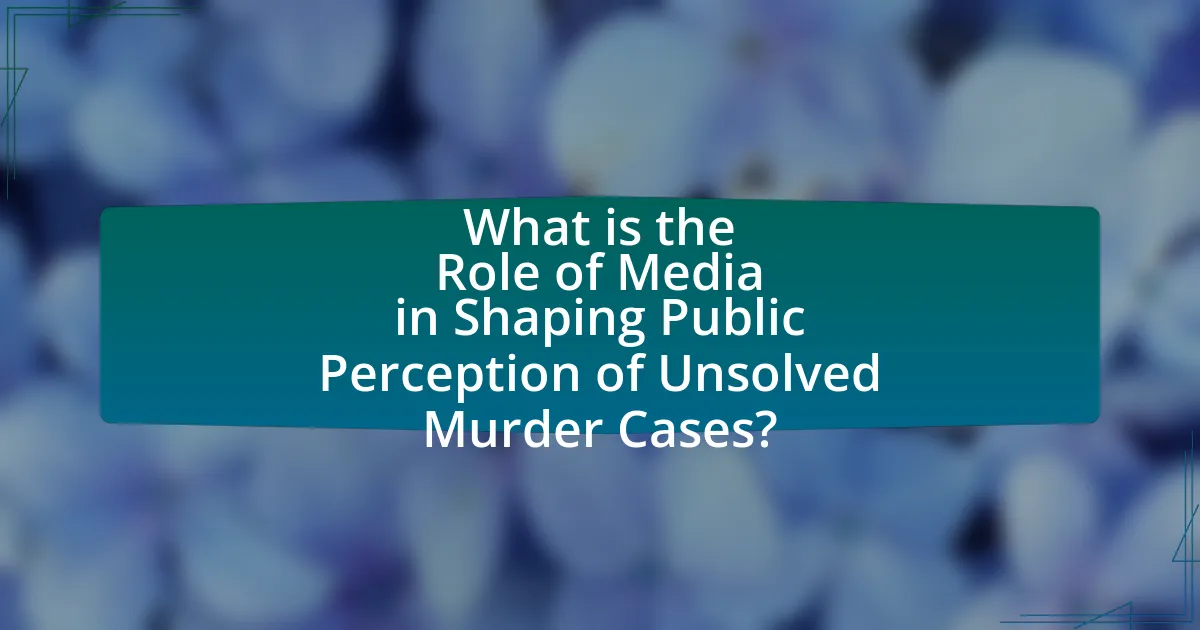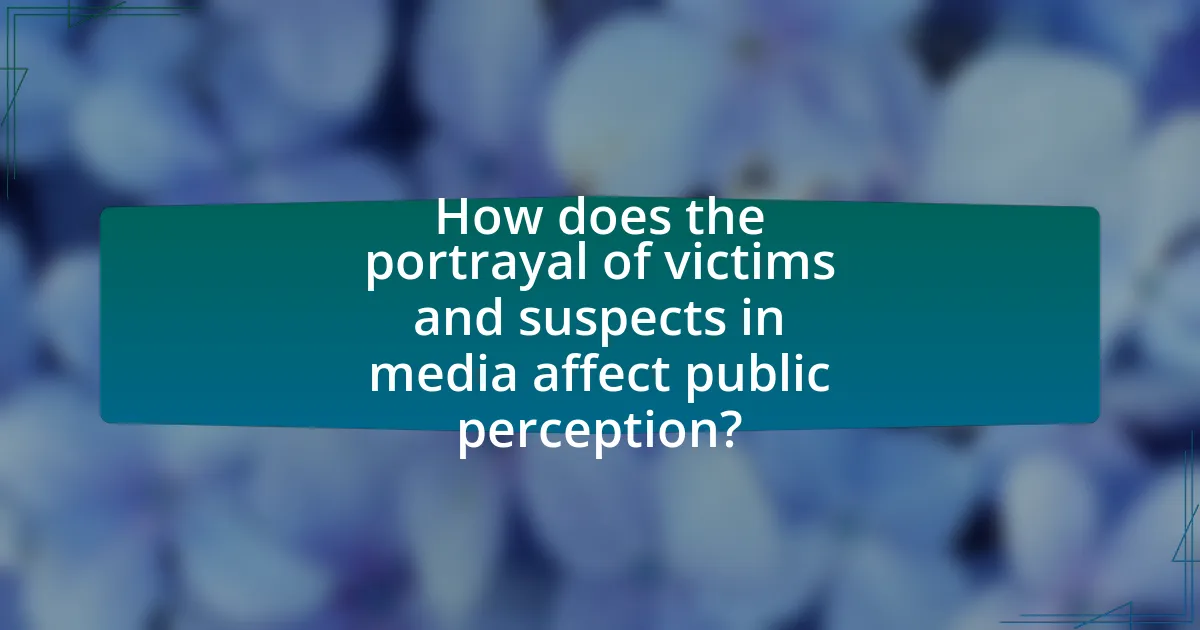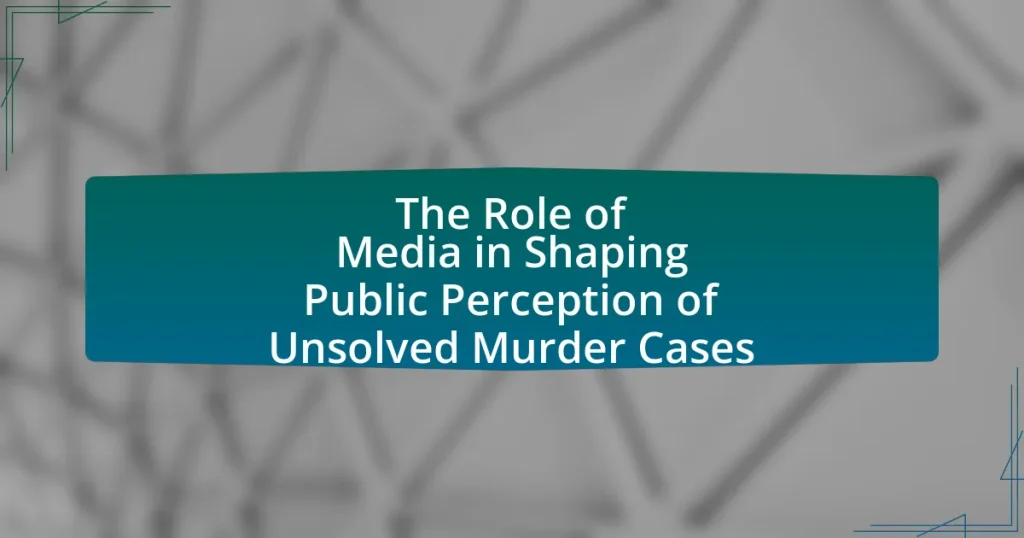The article examines the significant role of media in shaping public perception of unsolved murder cases. It highlights how media coverage influences narratives, public opinion, and community engagement, often leading to increased pressure on law enforcement to solve cases. The discussion includes the impact of sensationalized reporting, the portrayal of victims and suspects, and the ethical responsibilities of journalists. Additionally, it explores the consequences of media influence on investigations and offers strategies for mitigating negative effects while promoting responsible reporting practices.

What is the Role of Media in Shaping Public Perception of Unsolved Murder Cases?
The media plays a crucial role in shaping public perception of unsolved murder cases by influencing how information is presented and consumed. Through extensive coverage, the media can create narratives that highlight certain aspects of a case, such as the victim’s background or the circumstances of the crime, which can evoke emotional responses from the public. Research indicates that sensationalized reporting can lead to increased public interest and pressure on law enforcement, as seen in cases like the disappearance of Madeleine McCann, where media coverage significantly impacted public awareness and involvement. Additionally, the framing of these cases can affect public opinion regarding the effectiveness of the justice system, often leading to calls for reforms or changes in investigative practices.
How does media coverage influence public opinion on unsolved murder cases?
Media coverage significantly influences public opinion on unsolved murder cases by shaping narratives and highlighting specific details that capture public interest. When media outlets extensively report on a case, they can create a sense of urgency and emotional engagement among the audience, leading to increased public awareness and discussion. For instance, studies have shown that high-profile cases, such as the disappearance of Madeleine McCann, received extensive media attention, which not only kept the case in the public eye but also generated widespread speculation and theories among the public. This phenomenon can lead to pressure on law enforcement agencies to solve the case, as public sentiment often sways towards demanding justice. Furthermore, the framing of the case by the media—whether it emphasizes victimhood, potential suspects, or community impact—can significantly alter how the public perceives the case and its complexities.
What types of media are most impactful in shaping perceptions?
Visual media, particularly television and film, are the most impactful in shaping perceptions. Research indicates that visual storytelling can evoke strong emotional responses, influencing public opinion and attitudes towards crime and justice. For instance, a study published in the Journal of Communication found that crime dramas significantly affect viewers’ perceptions of crime rates and the effectiveness of law enforcement. Additionally, social media platforms amplify narratives surrounding unsolved murder cases, allowing for rapid dissemination of information and public engagement, which further shapes collective perceptions.
How do sensationalized stories affect public perception?
Sensationalized stories significantly distort public perception by amplifying emotions and biases surrounding events. These stories often prioritize dramatic elements over factual accuracy, leading audiences to form skewed opinions based on fear, outrage, or sensationalism rather than objective analysis. Research indicates that sensationalized media coverage can increase public anxiety and misperceptions about crime rates, as seen in studies by the Pew Research Center, which found that sensational reporting can lead to heightened fear of crime despite statistical evidence showing declines in certain types of crime. This distortion can influence public discourse, policy decisions, and even the judicial process, as communities react to the heightened emotions generated by sensationalized narratives.
Why is public perception important in the context of unsolved murder cases?
Public perception is crucial in unsolved murder cases because it can significantly influence investigative outcomes and community engagement. When the public is actively involved and aware, they are more likely to provide tips and information that can lead to breakthroughs in cases. For instance, high-profile unsolved cases often receive extensive media coverage, which can mobilize public interest and encourage witnesses to come forward. Research indicates that community involvement can enhance the effectiveness of law enforcement efforts, as seen in cases like the Golden State Killer, where public tips, spurred by media attention, led to an arrest decades later. Thus, positive public perception can create a collaborative environment that aids in solving these complex cases.
How can public perception influence law enforcement efforts?
Public perception significantly influences law enforcement efforts by shaping priorities, resource allocation, and community cooperation. When the public perceives a crime as a high priority, law enforcement agencies often respond by dedicating more resources and attention to that issue, as seen in cases where media coverage amplifies community concerns about unsolved murders. For example, heightened media attention can lead to increased public pressure on police departments to solve specific cases, prompting them to adopt new investigative strategies or collaborate with external agencies. Additionally, positive public perception can enhance community trust, leading to greater cooperation from witnesses and informants, which is crucial for solving crimes. Conversely, negative perceptions can result in community disengagement and reluctance to assist law enforcement, ultimately hindering investigations.
What role does public pressure play in solving unsolved cases?
Public pressure significantly aids in solving unsolved cases by increasing visibility and urgency around investigations. When the public becomes actively engaged, it can lead to renewed interest from law enforcement, prompting them to allocate more resources or revisit evidence. For instance, high-profile cases like the murder of JonBenét Ramsey have seen public campaigns that keep the case alive in media, leading to new tips and leads. Additionally, studies indicate that cases receiving extensive media coverage often result in higher rates of resolution, as public awareness can motivate witnesses to come forward.
What are the ethical considerations for media in reporting on unsolved murder cases?
The ethical considerations for media in reporting on unsolved murder cases include the responsibility to avoid sensationalism, respect for victims’ families, and the potential impact on ongoing investigations. Media outlets must prioritize factual accuracy and refrain from speculative reporting that could mislead the public or compromise law enforcement efforts. For instance, the Society of Professional Journalists emphasizes the importance of minimizing harm, which is particularly relevant in sensitive cases involving unresolved crimes. Additionally, ethical reporting should consider the emotional toll on victims’ families, ensuring that coverage does not exploit their grief for ratings or attention. By adhering to these ethical standards, media can contribute positively to public discourse while maintaining integrity in their reporting.
How can media balance sensationalism with responsible reporting?
Media can balance sensationalism with responsible reporting by adhering to ethical journalism standards that prioritize accuracy and context over dramatic narratives. Responsible reporting involves verifying facts, providing comprehensive background information, and avoiding misleading headlines that exaggerate the story’s emotional impact. For instance, the Society of Professional Journalists emphasizes the importance of minimizing harm and acting independently, which helps mitigate sensationalism. By focusing on factual reporting and the broader implications of unsolved murder cases, media can inform the public without resorting to sensational tactics that distort reality.
What responsibilities do journalists have when covering these cases?
Journalists have the responsibility to report accurately and ethically when covering unsolved murder cases. This includes verifying facts, avoiding sensationalism, and respecting the privacy of victims’ families. Ethical journalism standards, such as those outlined by the Society of Professional Journalists, emphasize the importance of minimizing harm and providing context to avoid misleading the public. Furthermore, journalists should strive to present balanced perspectives, ensuring that all relevant voices are heard, which contributes to a more informed public discourse on these sensitive issues.

How does the portrayal of victims and suspects in media affect public perception?
The portrayal of victims and suspects in media significantly influences public perception by shaping narratives that can lead to biases and stereotypes. When media outlets emphasize certain characteristics of victims, such as their socioeconomic status or lifestyle, it can evoke sympathy or blame, affecting how the public views the case. For instance, research by the American Psychological Association indicates that media framing can lead to victim-blaming, where victims are perceived as responsible for their circumstances based on how they are portrayed. Similarly, the depiction of suspects often relies on racial or socioeconomic stereotypes, which can skew public opinion and lead to prejudiced views. A study published in the Journal of Communication found that sensationalized portrayals of suspects can increase fear and demand for punitive measures, further influencing public attitudes toward crime and justice. Thus, the media’s portrayal of both victims and suspects plays a crucial role in shaping societal perceptions and responses to crime.
What narratives are commonly constructed around victims in unsolved murder cases?
Victims in unsolved murder cases are often portrayed through narratives that emphasize their innocence, vulnerability, and the tragedy of their untimely deaths. These narratives typically highlight the victim’s background, personal relationships, and the impact of their loss on family and community, creating a sympathetic image that resonates with the public. For instance, media coverage frequently focuses on the victim’s life story, showcasing their aspirations and the potential that was lost, which can evoke emotional responses and foster public interest in the case. Additionally, the portrayal may include elements of mystery and fear, suggesting that the unresolved nature of the crime poses a threat to the community, thereby amplifying the urgency for justice. This construction of narratives serves to humanize the victim, making their story relatable and compelling, which can influence public perception and engagement with the case.
How do these narratives shape empathy or indifference among the public?
Narratives in media significantly shape public empathy or indifference towards unsolved murder cases by influencing emotional engagement and perception of victimhood. When media portrays victims as relatable individuals with compelling backstories, it fosters empathy among the audience, as seen in cases like the coverage of the murder of Elizabeth Smart, which generated widespread public support and advocacy for missing persons. Conversely, narratives that focus on sensationalism or depersonalize victims can lead to indifference, as demonstrated in the coverage of certain violent crimes where victims are portrayed merely as statistics, resulting in a lack of public outcry or engagement. This duality in narrative framing directly impacts how the public responds emotionally and socially to these cases.
What impact does victim representation have on community responses?
Victim representation significantly influences community responses by shaping public empathy and mobilizing collective action. When victims are portrayed in a relatable and humanized manner, communities are more likely to engage in advocacy efforts, support initiatives for justice, and participate in discussions surrounding crime prevention. Research indicates that media coverage that emphasizes the victim’s story can lead to increased public awareness and pressure on law enforcement to solve cases, as seen in the heightened community involvement following the coverage of high-profile unsolved murders. This connection between representation and community response underscores the media’s role in not only informing the public but also in galvanizing community support for victims and their families.
How are suspects portrayed in media coverage of unsolved murder cases?
Suspects in media coverage of unsolved murder cases are often portrayed in a sensationalized manner, emphasizing their alleged guilt and creating a narrative that can influence public perception. This portrayal frequently includes the use of dramatic language, visual imagery, and speculative commentary that can lead to a presumption of innocence being overshadowed by public opinion. Research indicates that such coverage can result in a significant impact on the community’s perception, often leading to stigmatization of individuals identified as suspects, regardless of their actual involvement in the crime. For instance, a study published in the Journal of Criminal Justice found that media framing can shape audience attitudes towards suspects, often portraying them as dangerous or morally culpable, which can affect jury pools and public sentiment surrounding ongoing investigations.
What biases can emerge in the portrayal of suspects?
Biases that can emerge in the portrayal of suspects include racial bias, socioeconomic bias, and confirmation bias. Racial bias often leads to the disproportionate representation of minority groups as suspects, which can skew public perception and reinforce stereotypes. Socioeconomic bias may result in the portrayal of suspects from lower-income backgrounds as more likely to commit crimes, while those from affluent backgrounds may be depicted more sympathetically. Confirmation bias occurs when media outlets selectively report information that aligns with existing narratives about a suspect, ignoring evidence that contradicts those narratives. Studies have shown that media framing can significantly influence public opinion, as evidenced by research from the American Psychological Association, which highlights how biased reporting can shape societal attitudes toward different demographic groups.
How does this portrayal affect public opinion and potential leads?
The portrayal of unsolved murder cases in the media significantly influences public opinion and potential leads. When media coverage emphasizes certain narratives, such as victim stories or sensational details, it can evoke emotional responses from the audience, leading to increased public interest and engagement. For instance, a study by the Pew Research Center found that 63% of Americans believe media coverage can help solve crimes by encouraging tips from the public. This heightened awareness can result in more individuals coming forward with information, thereby increasing the likelihood of generating leads that could assist law enforcement in solving cases.

What are the consequences of media influence on public perception of unsolved murder cases?
Media influence significantly shapes public perception of unsolved murder cases, often leading to heightened emotional responses and skewed interpretations of the facts. This influence can result in increased public pressure on law enforcement to solve cases, which may lead to rushed investigations or misallocation of resources. Additionally, sensationalized coverage can create a narrative that oversimplifies complex situations, potentially leading to wrongful assumptions about suspects or victims. Research indicates that media framing can affect juror biases and public opinion, as seen in studies like “The Impact of Media Coverage on Public Perception of Crime” by the Pew Research Center, which highlights how media portrayal can distort reality and influence community reactions.
How does media influence the investigation process of unsolved cases?
Media significantly influences the investigation process of unsolved cases by shaping public awareness and engagement. When media outlets cover a case extensively, they can generate public interest, leading to increased tips and information from the community. For instance, the case of the Golden State Killer saw a resurgence in public interest due to media coverage, which ultimately contributed to the arrest of the suspect through DNA evidence linked to genealogy databases. Additionally, media can pressure law enforcement agencies to allocate more resources to cold cases, as seen in various high-profile unsolved murders that gained national attention. This dynamic illustrates how media not only informs the public but also actively participates in the investigative process by mobilizing community involvement and influencing police priorities.
What are the potential benefits of increased public interest generated by media?
Increased public interest generated by media can lead to heightened awareness and engagement in unsolved murder cases. This engagement often results in more tips and leads from the community, which can assist law enforcement in solving cases. For instance, the case of the Golden State Killer saw a resurgence of public interest due to media coverage, ultimately leading to the arrest of the suspect through DNA evidence and public tips. Additionally, increased media attention can foster a sense of urgency and pressure on authorities to act, as seen in various high-profile cases where public outcry has prompted investigations to be reopened or prioritized.
What risks are associated with media involvement in ongoing investigations?
Media involvement in ongoing investigations poses several risks, including the potential for compromising the integrity of the investigation. When media outlets report on sensitive details, they may inadvertently reveal information that could influence witness testimonies or alert suspects, thereby hindering law enforcement efforts. For instance, the release of specific evidence or investigative strategies can lead to suspects altering their behavior or fleeing, as seen in high-profile cases where premature media coverage affected the outcome of investigations. Additionally, sensationalized reporting can create public pressure on law enforcement, leading to rushed decisions that may not be in the best interest of justice. This dynamic can distort public perception, as the narrative shaped by the media may not accurately reflect the complexities of the case, ultimately impacting the pursuit of truth and justice.
What strategies can be employed to mitigate negative media influence?
To mitigate negative media influence, implementing media literacy programs is essential. These programs educate individuals on critically analyzing media content, helping them discern fact from sensationalism. Research indicates that media literacy can significantly reduce the impact of misleading information; for instance, a study by the National Association for Media Literacy Education found that students who participated in media literacy initiatives demonstrated improved critical thinking skills regarding media consumption. Additionally, promoting responsible journalism practices, such as fact-checking and ethical reporting, can further diminish negative portrayals in the media. By fostering a culture of accountability among media outlets, the potential for harmful narratives surrounding unsolved murder cases can be significantly reduced.
How can law enforcement agencies effectively communicate with the media?
Law enforcement agencies can effectively communicate with the media by establishing clear, consistent messaging and maintaining regular contact with journalists. This approach ensures that accurate information is disseminated, which is crucial in shaping public perception, especially in sensitive cases like unsolved murders. Agencies should designate a public information officer to serve as the primary point of contact, facilitating timely updates and responses to media inquiries. Research indicates that proactive communication can enhance public trust and cooperation, as seen in the FBI’s use of media briefings during high-profile investigations, which helped garner community support and tips.
What role can community engagement play in shaping a positive narrative?
Community engagement plays a crucial role in shaping a positive narrative by fostering trust and collaboration between the public and law enforcement. When communities actively participate in discussions and initiatives related to unsolved murder cases, they contribute valuable insights and local knowledge that can enhance investigative efforts. For instance, community-led forums have been shown to increase awareness and generate leads, as seen in the case of the “Cold Case Project” in various cities, where community involvement led to the resolution of previously unsolved cases. This collaborative approach not only empowers residents but also helps to humanize victims, shifting the narrative from mere statistics to personal stories, thereby promoting a more compassionate public perception.
What best practices should media follow when reporting on unsolved murder cases?
Media should prioritize accuracy, sensitivity, and ethical considerations when reporting on unsolved murder cases. Accurate reporting involves verifying facts and avoiding speculation, as misinformation can hinder investigations and mislead the public. Sensitivity is crucial; media should respect the victims’ families and avoid sensationalism that could exacerbate their grief. Ethical considerations include not disclosing details that could compromise ongoing investigations or endanger individuals involved. For instance, the Society of Professional Journalists emphasizes the importance of minimizing harm and acting in the public interest, which reinforces the need for responsible reporting in such sensitive cases.


